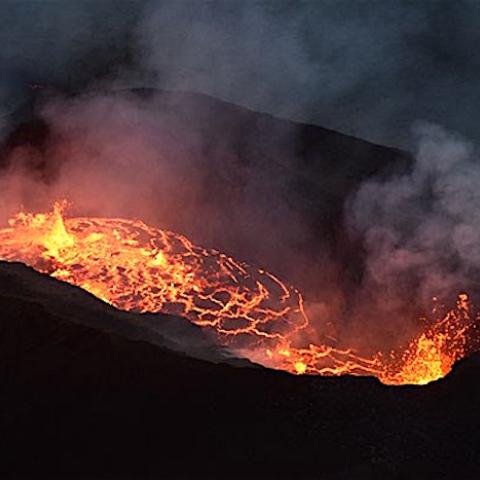
Sunrise is reflected in the windows of the NPS and USGS buildings that will be deconstructed and removed at Uēkahuna bluff at the summit of Kīlauea volcano in Hawaiʻi Volcanoes National Park in the weeks ahead/NPS, J. Wei
Five years after the eruption of the Kīlauea volcano at Hawai'i Volcanoes National Park damaged facilities near the volcano's crater, work has begun to deal with the buildings. The work aims to repair, improve, or remove damaged buildings and infrastructure at the summit.
On Wednesday, contractors fenced off Jaggar Museum, the former U.S. Geological Survey Hawaiian Volcano Observatory (USGS HVO) buildings at Uēkahuna and part of the parking lot. The buildings were structurally damaged during the 2018 Kīlauea eruption and summit collapse and will be removed in the weeks ahead.
Crater Rim Drive will also be realigned to improve safety and reduce congestion at the park entrance. An administrative lane will be added, and a roundabout will be installed beyond the entrance station. Unless extensions are granted, the contract for Phase One of the Disaster Recovery Project is 600 days.
“Park visitors, tour operators and the community should expect reduced parking, delays at the entrance station, and the potential for temporary area closures, especially if a summit eruption occurs during construction,” said Hawaiʻi Volcanoes Superintendent Rhonda Loh. “We thank our partners, visitors and the community for their patience during this process.”
Half the parking lot at Uēkahuna is blocked for the construction project staging area. Vehicles longer than 25 feet and wider than eight feet will not be allowed past Kilauea Military Camp, and the gravel overflow parking lot at Kīlauea Visitor Center will also be secured as a staging area.
The park will restore Uēkahuna to a more natural landscape, considered by Native Hawaiians and other groups as a sacred area. The buildings will be removed but the observation deck will remain. Interpretive displays will be minimal as to not impede the panoramic views or influence how individuals interpret the sense of place.
Construction of the new USGS HVO field station near the historic ballfield at Kilauea Military Camp is also underway but is not expected to have major impacts on visitation. Some materials from the original HVO buildings, like decorative stained glass, plaques, rock work and other materials, will be used in the new facility.
Phase Two of the Disaster Recovery Project includes the rehabilitation of Kīlauea Visitor Center. That is slated to begin as early as this Fall.
Hawaiʻi Volcanoes National Park and Kīlauea summit underwent a massive change in 2018 when magma drained from the chamber beneath Halema‘uma‘u crater. The caldera collapsed and triggered thousands of earthquakes and clouds of rock and ash between May and August 2018. The seismic activity was centered near the crater, and significantly impacted buildings and roads in the vicinity of Uēkahuna. Most of the park closed for 134 days.
Visitors are advised to stay informed of construction-related updates and delays by planning ahead and checking the park website.




 Support Essential Coverage of Essential Places
Support Essential Coverage of Essential Places






